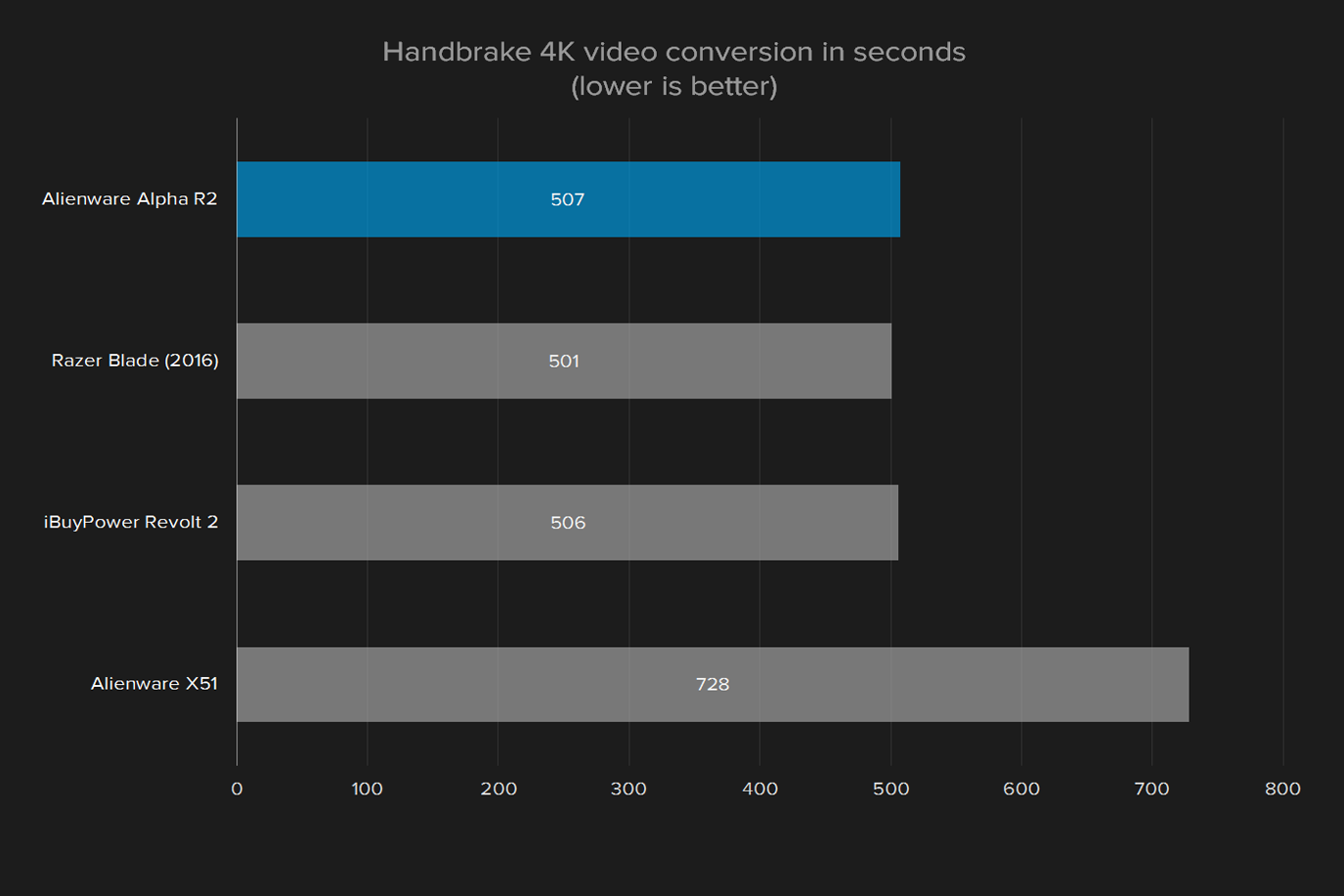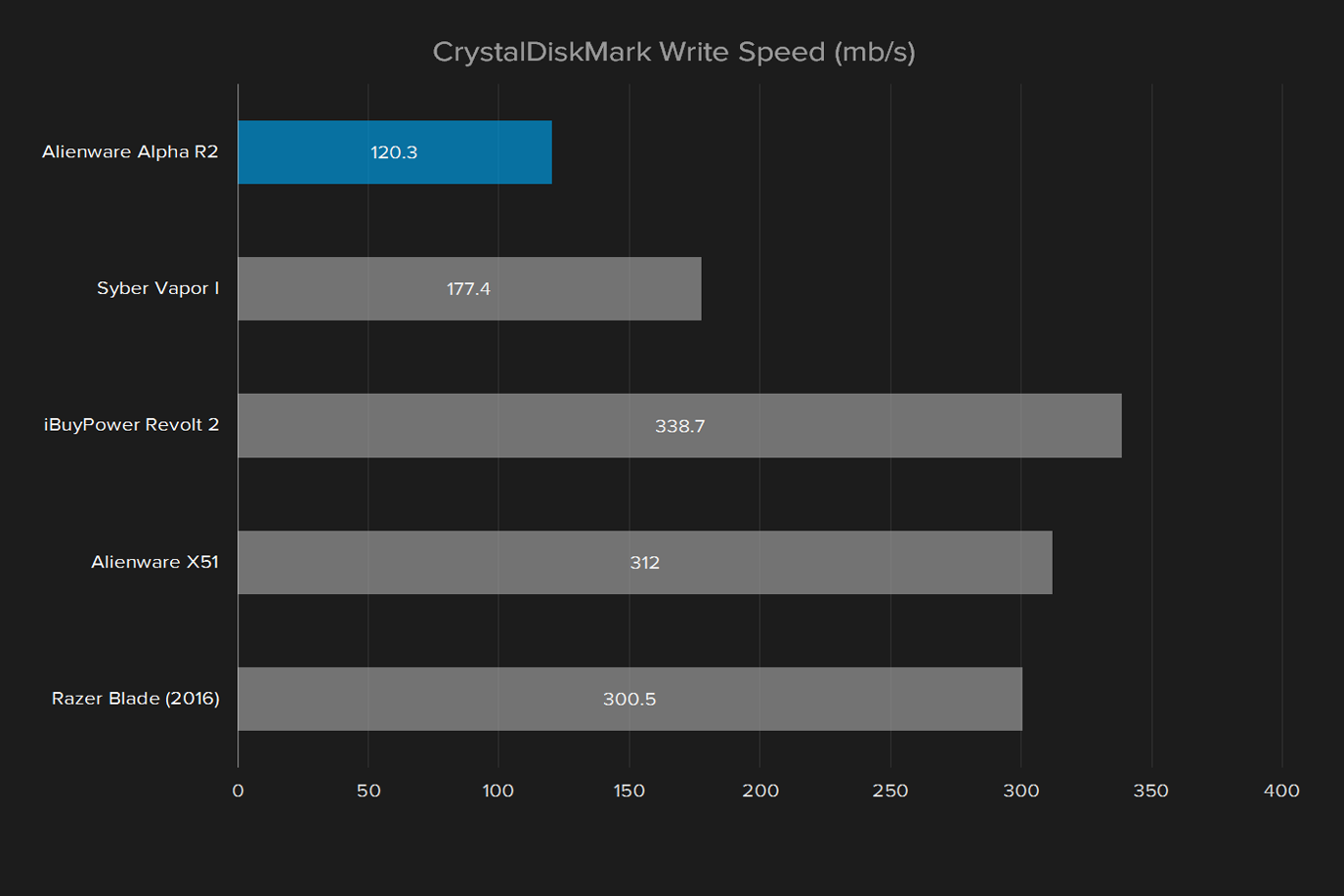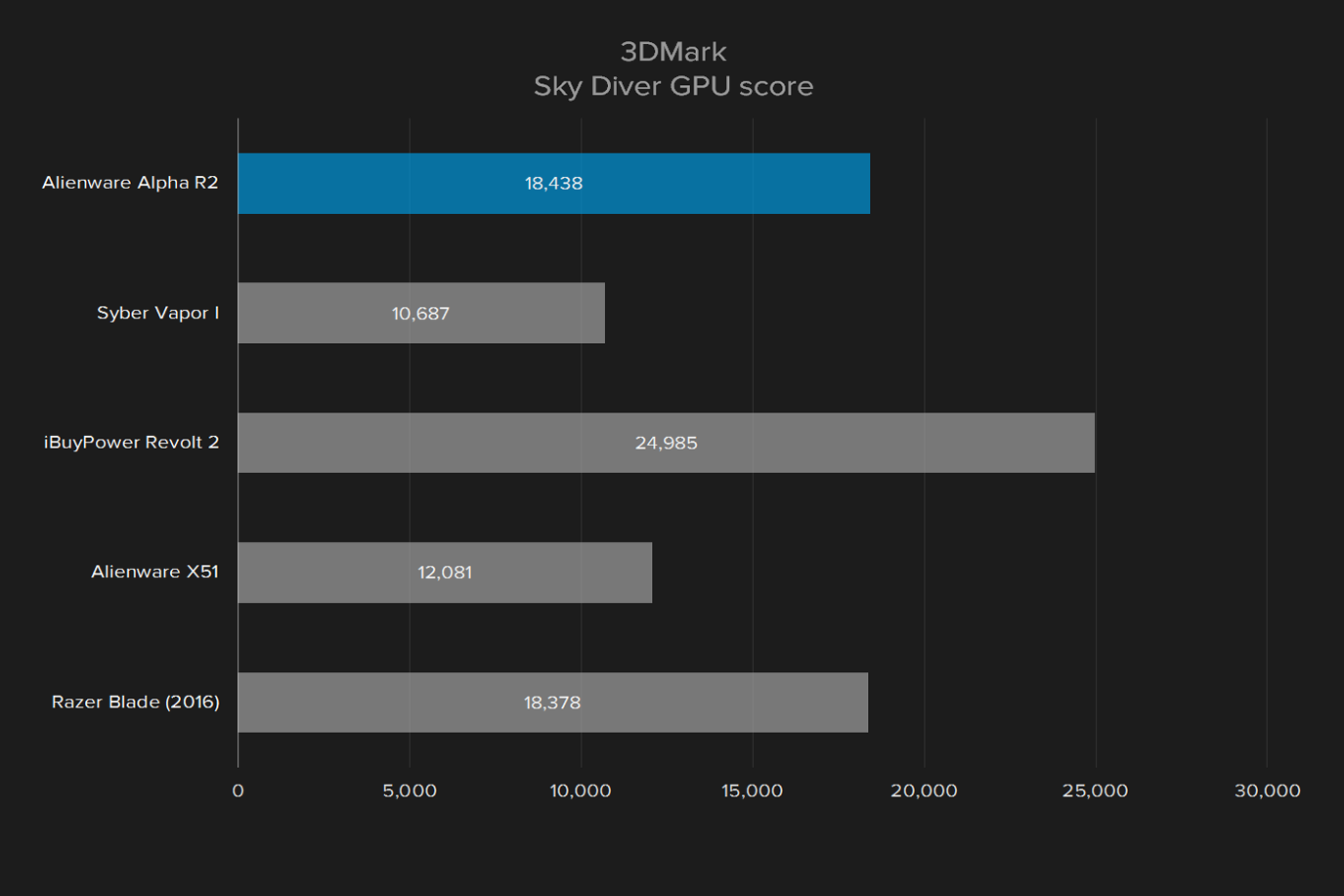- Solid 1080p performance
- Compact, sturdy design
- Decent price point
- Highly upgradable
- No more SteamOS
- Runs hot and loud
- SSD upgrade is a must
Alienware’s first Alpha systems were the poster boy for the Steam Machine project. A well-known gaming company, producing a first-rate machine, with everyone’s favorite platform – what’s not to love?
Well, as it turned out, quite a bit. The Linux-based OS suffered from limited game compatibility, followed by reports of slower performance when running games on SteamOS than on Windows. The previous Alpha generations only offered a single GPU, simply described as a “Geforce GTX GPU” which, while attractive to console gamers looking for simpler options, didn’t satisfy PC gamers.
Now the Alpha is back with a full-blown GTX 960, 6th-gen Intel Core processor, and an improved outlook on life. Our review unit was powered by the Intel Core i7-6700T with 8GB of RAM, the aforementioned GTX 960, and a 1TB mechanical drive, all for $949. With the Alienware X51 officially retired, and SteamOS replaced by Windows, is this the Alpha’s time to shine?
Size matters
While the internals have changed dramatically, the exterior hasn’t changed at all. The Alpha is still a squat, square box with a single beveled front corner. It’s noticeably smaller than a current-gen console, at just eight inches deep and wide, and its understated design will look right at home next to a TV or stereo equipment.
It’s an Alienware product, which means RGBLED lighting is standard, both on the Alienware logo / power button, and on the front corner. Users can change them at will, coordinate them with games, or shut them off altogether using bundled software.
Overall, the build quality is high enough to meet the standards we have for Dell’s gaming brand. It overcomes the cheap plastic feel that’s so common among small systems. It’s still no match for full custom rigs like the Origin Chronos, but given the Alpha’s price, we don’t expect it to compete on that level.
Last year’s plugs
The Alpha has five USB ports in total — a pair of 3.0 in the front, another pair in the back, and a 2.0 port hidden underneath a panel on the bottom of the Alpha – a perfect spot for a wireless keyboard, mouse, or controller adapter. The back also features an Ethernet port, optical audio out, and a proprietary connection for the Alienware Graphics Extender, should you want a beefier graphical option.
The lack of DisplayPort and Type-C, or Thunderbolt, is a bit disappointing in 2016.
Compared to even smaller systems like the Intel Skull Canyon NUC, the connectivity available is expansive, if not a little archaic. The distinct lack of DisplayPort and Type-C or Thunderbolt is more noticeable in 2016 than in previous years. Since Alienware reconfigured connections for this version, it would’ve been nice if they had found room for something a little more cutting edge.
While the wired connectivity falls behind systems with more traditional motherboards, the Alpha makes up for it with wireless connections. An 802.11ac card is standard, with the option to upgrade to a 2×2 card for just $25. Bluetooth 4.2 is included, too.
Cramped, but accessible
Taking apart the Alpha is simple enough. Only four screws hold the case to the Alpha’s internals, and with a little prying that shell clicks away, leaving just the internals in a metal frame. Accessing the memory means removing the CPU’s fan shroud, easy enough thanks to some tool-less clips.
Once it’s off, a small heatsink covers the CPU. Remove it, and you’ll find a standard chip, which can be upgraded to any LGA1151 chip (though, give the size of the Alpha, you’d be wise not to try stuffing in a Core i7-6700K).
The hard drive is on the underside, with a quartet of screws holding it in. Unfortunately, Alienware’s use of more common hardware doesn’t extend to the GPU, the only component inside permanently attached to the motherboard.
Still, we have to give Alienware points for making sure the rest of the parts are accessible, and the CPU can be upgraded – a rarity in systems this small.
A surprisingly quick chip
The Core i7-6700T is the beating heart of our review unit. It’s quad-core chip with Hyper-Threading, a 2.8GHz base clock, and 3.6GHz Turbo Boost. The only caveat is a limited 35 watt thermal design power (TDP). As a reference, the full-power Core i7-6700 has a 3.4Ghz base clock, and a 65 watt TDP. The Core i7-6700K is clocked at 4GHz, and has a 91 watt TDP. In demanding tests, especially over time, the Alpha is bound to fall behind.
Or not. Much to our surprise, the Alpha R2 manages to keep pace with other compact systems in its wake, and even competes with much more powerful chips like the non-overclocked Core i7-6700K in the iBuyPower Revolt 2.
Its single-core speeds suffer a bit, as seen in the GeekBench test, but in well-threaded loads it has no issue, tying the iBuyPower’s result. It converts a 4K movie trailer using Handbrake within six seconds of both the Revolt 2 and the Razer Blade, which are powered by the Core i7-6700K and Core i7-6700HQ, respectively.
The low-power 6th-generation Core CPU in the Alpha R2 is the little chip that could, and not nearly as much of a compromise as we worried it might be.
Move on from mechanical
The sole hard drive in our review unit is, unfortunately, a 7,200RPM mechanical drive. It’s one terabyte capacity is some consolation. Who knows? Maybe it will surprise us like the CPU did.
In case it isn’t abundantly clear, the mechanical drive’s results are bad. The drive in the Alpha basically tied with mid-range portable USB drives, and it’s a far cry from eSATA SSDs found in most machines, let alone the PCIe drives that are becoming the standard.
The tortoise-like drive adversely affects everyday use, to say the least. We’re so used to SSD-fueled systems booting up immediately that it’s almost confusing when the Alpha takes it sweet time starting Windows.
The good news is that for only $100 more, users can customize their system with a 256GB M.2 PCIe drive instead of the data drive, or get both for $200. We’d strongly advise taking either of those options, or picking up a M.2 drive and installing it yourself.
So far, so good
The last Alpha was powered by a GPU that was simply described as a “GTX GPU with 2GB GDDR5.” That’s not very descriptive, to say the least, and that irked a lot of users who preferred to know what they were working with. This time around, Alienware is packing in a real live GTX 960 with 4GB of graphical memory.
That desktop chip performs close enough to the stock GTX 960 in the Alienware X51 that it’s within the margin of error, which is good news, considering its custom footprint. It trades blows with the GTX 970M found in the 2016 Razer Blade, sneaking past it in Sky Diver, and losing some ground in the more challenging Fire Strike test.
That means the Alpha should perform similarly to the X51, as well as mobile gaming options like the Razer Blade. We’re used to seeing those systems offer decent performance at 1080p, and fall off at higher resolutions.
Game on
Now that the Alpha is done jumping through hoops, it’s time to get to the fun stuff – gaming! The Alpha’s GTX 960 is certainly an upgrade from the last iteration’s mysterious “GeForce GTX GPU,” and it should bring a respectable performance increase along with it.
Performance is basically in line with the Alienware X51, which is impressive considering that system has a few inches on the comparatively tiny Alpha. At 1080p, at least, the system hit the framerate cap in Counter-Strike: Global Offensive at medium settings, and flew past all but the most serious mobile gaming solutions, like the 2016 Razer Blade with a GTX 970M.
Fallout 4 was a similar story, where the Alpha hit 54 frames per second average, at 1080p and ultra settings. That’s a near-perfect performance point for modern AAA games, and once again tied the X51.
The now retired Alienware X51 carried a $1,500 price tag — so for $500 less, the Alpha packs the same performance in a smaller package.
Loud and sweaty
Sounds great, right? For the most part, it is. But the Alpha can’t disobey the laws of physics. The hardware puts off a lot of heat, and there’s not much room to dissipate it.
Under load, the Alpha has to work hard to keep cool, and it doesn’t take much to stir the blower fans on the GPU and CPU into a frenzy. The result was a noise reading of 44.2 decibels with 7-Zip taxing the CPU, and 55.4 with FurMark’s GPU stress test running.
It’s noticeably smaller than a current-gen console, and will look right at home next to a TV.
While the fans do their job, they of course exhaust heat outside the system, which means the air around the Alpha can get warm. The top reaches a sweltering 118 degrees Fahrenheit under load. That’s not a problem for the rig’s performance, but it might be a problem for the target market.
The Alpha is designed to sit next to a TV, a console, or in an entertainment stand with other home audio/video equipment. Its extreme heat and externally blowing fans, a necessity of its size, mean you’ll need to keep it somewhere that’s ventilated. But leaving it out in the open won’t do anything to help shut it up.
Fortunately, it’s not alone in its problems staying cool under pressure. Many similar compact gaming systems, from dedicated gaming laptops to high-end compact desktops like the Origin Chronos, break 50 decibels under load.
Like SteamOS never existed
The first Alpha launched as part of the Steam Machine program, designed with SteamOS in mind. This time around, you won’t find any mention of Valve’s operating system – it’s Windows 10 all the way down.
While that’s sure to please the veteran PC gamers, it’s definitely worth noting that setting up the Alpha isn’t as simple as plugging in a Playstation. Windows 10 isn’t designed to operate at ten feet, at least right out of the box, so you’ll want to bump the magnification and set up Steam to run in Big Picture mode if you usually rely on a controller.
The benefits are numerous. The SteamOS library is fairly limited at this point, and on games that are available, performance is noticeably worse than in Windows. While SteamOS has a desktop mode, it’s hardly as versatile or widely-used as Windows 10.
Platform development can be a vicious cycle, and those factors combined have rendered SteamOS largely irrelevant in PC gaming discussions. It’s hard to argue the move to Windows isn’t worth the ~$100 bump in price.
Keep the box
The Alpha includes a one year limited hardware warranty, which is fairly standard for the sub-$1,000 market. The customer is expected to supply the box, but Dell will pay shipping, so make sure you save the packaging in case something goes wrong.
The rain is gone
Alienware’s updated Alpha is a big step in the right direction for the Alpha itself, and for console-inspired PCs as a whole. Performance has improved considerably, as has connectivity, and the move to Windows 10 will delight wary PC gamers.
A similarly configured Syber Vapor is about $100 more with the same mechanical drive. An iBuyPower Revolt 2 is $1,227 with a 120GB SSD and a 2TB mechanical drive. You’ll pay $1,666 for the Origin Chronos. Neither brand will even let you configure the system without an SSD. These alternatives are much larger, too, so they may not actually fit beside a TV.
That makes the Alpha an excellent value. It’s also something you can’t build at home. Compact systems like the X51, or even the Chronos, are possible for an enthusiast to build, even if it’d be a bit of a chore. The Alpha, on the other hand, would be impossible to build from off-the-shelf parts. Its custom GPU and cooling solutions inaccessible to even skilled system builders.
The new Alpha’s performance improvements help soothe any pains caused by heat or noise. Its problems are small, its benefits many, and its performance more than adequate for playing PC games at 1080p. The Alpha is proof that, despite the demise of SteamOS, PC/console hybrids aren’t dead.























